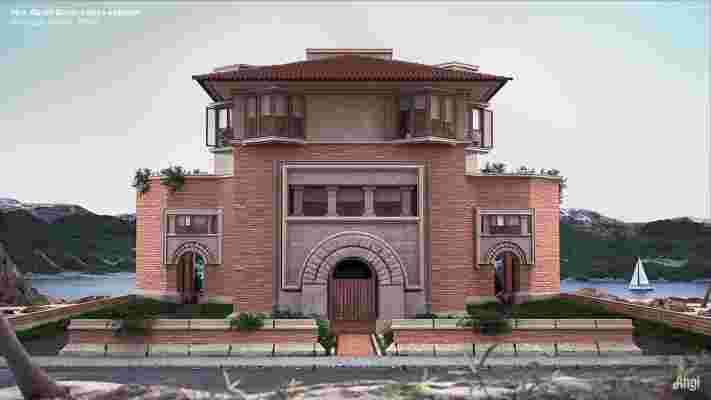Despite Frank Lloyd Wright’s stature as America’s preeminent architect, less than half of his 1,171 designs were ever built. Six decades after Wright’s death, the home-services website Angi (formerly Angie’s List) decided to bring three of his unrealized homes to life—virtually—using 3D computer technology.
Working with London-based NeoMam Studios, the visual content company that previously “restored” the Parthenon in Greece and Egypt’s Luxor Temple, Angi selected three unrealized homes for digital construction, from exteriors to furnished interiors. Each is from a different period in Wright’s life: an 1896 Chicago house designed for Mrs. David Devin, a Lake Tahoe lodge from 1923, and a Connecticut cottage envisioned for Atlas Shrugged author Ayn Rand in 1946.

The exterior of the Mrs. David Devin home, 1896.
“The most challenging part was designing the floor plans,” the team at NeoMam told Wallpaper . “The design team followed the plans and sketches as closely as possible, but some parts required additional research and an understanding of how existing FLW houses are built.” To develop the interiors, the studio took inspiration from well-known Wright projects like Hollyhock House and Taliesin West.

The floor plan for the Mrs. David Devin house.
In the late 1890s, Wright was commissioned to design a home for Chicago matron Aline Devin. He was still building his reputation and working out of his home. Though Devin encouraged him to think unconventionally, she ultimately rejected his experimental design, which was atypical of his later work. “The plans were much more unusual than FLW’s other plans and houses,” the team at NeoMam told Wallpaper . “[It] became our favorite because it stands out as different to the typical style that FLW is known for.”
In 1923, Wright began developing plans for an ultimately unrealized Lake Tahoe Summer Colony on some 200 acres surrounding Emerald Bay. According to the Frank Lloyd Wright Foundation, his designs included a collection of cottages along the shore, as well as a fleet of floating cabins in the bay itself. Wright’s plans for the Lodge included “massively walled terraces,” according to the Foundation, which provided an air of seclusion while anchoring the structure to the mountainside.
There was no commission for the work: Wright apparently hoped to draw Jessie Armstrong, the owner of the land, into a partnership. But the project never materialized. The Cottage Studio he drafted for Rand, meanwhile, is quite evocative of other works, especially Wright’s iconic Fallingwater. In a 1946 letter to Wright, the author and philosopher wrote she “gasped” when she saw his design. “It is the particular kind of sculpture in space which I love and which nobody but you has ever been able to achieve,” she said. According to Angi, the cottage was a union of “Rand’s severe streak” with Wright’s love of nature.

The exterior of the Ayn Rand studio in Connecticut, 1946.
“Concrete or stucco terraces thrust, cantilevered, from a softer fieldstone spine. And Wright’s addition of vines and fountains only accentuates the impression of a destroyer ship emerging from nature’s depths.” Rand first contacted Wright in 1937 while researching The Fountainhead. She insisted similarities between him and the book’s protagonist, uncompromising young architect Howard Roark, were only surface-deep, but many—Wright included—saw a much closer resemblance. (“I deny paternity and refuse to marry the mother,” Wright later said of the character and author.)
Rand envisioned the space as a retreat in Connecticut—or possibly, Los Angeles, if her screenwriting career took off—but she stayed in Manhattan and the project was scrapped. When the designs of an architect, even one as renowned as Wright, are brought into the real world, they must contend with the demands of clients, government agencies, and even the forces of nature.
NeoMam’s 3D renderings represent the closest approximation of Frank Lloyd Wright’s unfettered imagination. “The best buildings had life only on paper,” Wright wrote in his 1943 autobiography. “The most interesting and vital stories might belong to these children of imagination were they ever to encounter the field.”

Leave a Reply